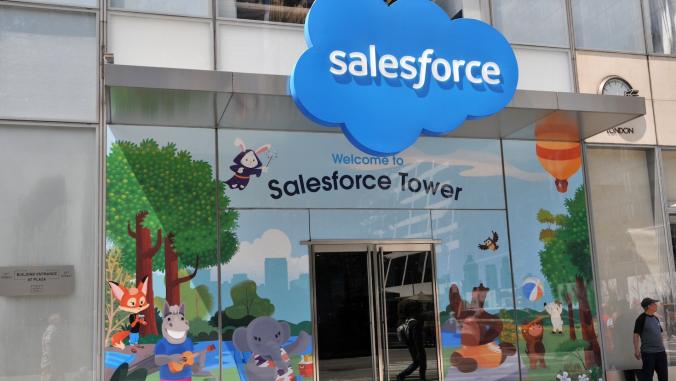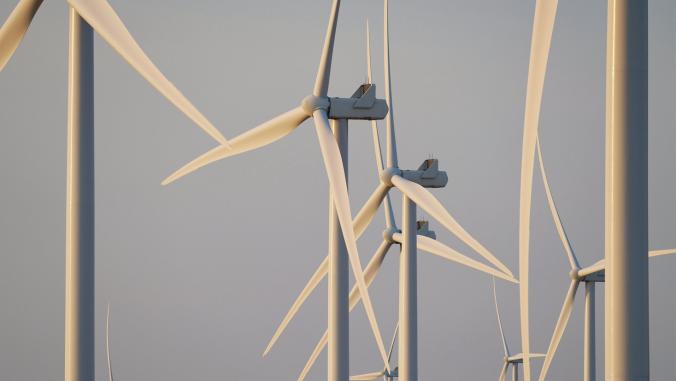Corporations bought a record 36.7 gigawatts in renewable energy last year, according to the latest figures from BloombergNEF. That was up a respectable 18 percent from 2021 levels. But the sheer size of those numbers overshadows a new reality as 2023 unfolds: The clean power procurement practices and models that have served corporate buyers so well for the past five or so years are in need of an overhaul.
Recent partnerships announced by Microsoft, through its unique link-up with turnkey solar supplier Qcells, and Salesforce, which is buying clean power in emerging markets, provide hints of what the future may hold.
A deal disclosed by Salesforce makes use of a relatively untried financial mechanism called distributed renewable energy certificates (DRECs), which help aggregate and certify the impact of multiple, small-scale projects. It highlights a growing concern among buyers: how to support projects in emerging economies.
The latest BNEF data underscores the current reality: A vast majority of all corporate purchases are centered on North America and Europe, largely because of favorable regulatory climates and the existence of power purchase agreement (PPA) contract structures that enable companies to offtake energy from wind and solar installation. Last year, for example, contracts in the Americas accounted for almost two-thirds of the total.
But the clean energy transition modeled by the International Energy Agency requires a massive investment in emerging and developing countries — at least $600 billion in capital investment — something that has failed to materialize. One challenge is that corporate clean energy buyers generally only receive credit for investments in regions in which they currently do business, under today’s carbon accounting rules and guidelines, something acknowledged by nine companies (including Salesforce) that created the Emissions First Partnership. Part of their mission statement: "As climate action has accelerated over the last decade, our organizations are ready to embrace an accounting framework that moves beyond the current approach of megawatt-hour matching, and focuses on the heart of the matter, emissions impact."
Centering climate justice
These companies aren’t waiting for permission to innovate. Under an agreement, San Francisco-based Salesforce will buy 280,000 megawatt-hours of clean power over the next eight years from small projects in Brazil, India, Southeast Asia and Sub-Saharan Africa, developed by aggregator Powertrust, headquartered in Vancouver, British Columbia.
To be clear, this is a tiny sliver of the renewable energy Salesforce procures each year in pursuit of its climate goals: In fiscal year 2023, ended Jan. 31, the company was involved in projects generating close to 850,000 MWh (pending an audit). The new project will generate roughly 35,000 annually.
Salesforce has set out parameters for new projects it deems appropriate including the location and how well a project will deliver on the SDGs related to climate resilience, universal energy access and gender equality.
But these projects would not have been possible without Salesforce’s support, according to Megan Lorenzen, senior manager of sustainability at the company, and author of its "More Than a Megawatt" report. "We are looking to procure renewable energy where we can have the most impact," she told me. "We see a dramatically different impact on carbon emissions in different grids and at different times of day."
The estimated investment in solar capacity will be $65 million, although Salesforce is providing only a portion of that amount, Lorenzen said.
Here’s a snapshot of the projects:
- Brazil — a solar installation that will replace diesel generators for a community along the Amazon, affecting about 1,000 people
- India — a solar microgrid in Nagaland, which will serve "an isolated mountain community" that doesn’t have access to electricity
- Sub-Saharan Africa — a solar-plus-energy storage system for a hospital that will power ventilators, operating rooms and organ support equipment; at least 30 percent of the jobs created are designated for women
- Southeast Asia — a solar microgrid that will be paired with a micro-hydro system in Borneo
Salesforce is receiving credit for its investment through DRECs — blockchain is helping gather the data, according to Lorenzen. The company has set out parameters for new projects it deems appropriate, including the proposed locations (priority is given to schools, hospitals, public service facilities and disadvantaged communities), and how well a project will deliver on the U.N. Sustainable Development Goals related to climate resilience, universal energy access and gender equality. "The generation is recorded, aggregated and validated," she said.
About that unusual Microsoft, Qcells deal
While Salesforce is looking outside the U.S. with its latest strategy, the relationship Microsoft disclosed in late January with solar company Qcells is very much focused on its ability to keep supporting new development in the United States.
The deal provides for Microsoft to buy "at least" 2.5 gigawatts in solar panels from Qcells. The solar company’s South Korean parent, Hanwha Group, is investing $2.5 billion to build manufacturing facilities in rural Georgia, a development made possible through a tax credit in the Inflation Reduction Act. Aside from the panels, Qcells also provides engineering, procurement and construction services for solar installations.
Brian Janous, general manager of energy and renewables at Microsoft, said there were two major drivers for the relationship, which took more than a year to negotiate: the COVID-triggered supply chain constraints that have made it tougher to get projects off the ground over the past two years; and his company’s realization that it might be able to use its buying power to negotiate more favorable supply relationships directly. Microsoft in July 2021 pledged to match all of its power consumption with zero-carbon energy purchases. As of that time, its collective contracts for clean power (not just solar) were 7.8 billion globally. The deal also addresses concerns over tariffs that the U.S. has placed on panels imported from China, and that could affect four other Southeast Asian nations by June 2024.
"The most important benefit is going to be flexibility and speed," Janous told me. "That is the thing that keeps me up at night, is just understanding the industry challenges," which range from tariffs to slow interconnection permitting cycles to grid stability. "It’s remarkable what we have managed to get done," he said, referring to the growth in corporate renewable purchases. "The next 10 years is going to be even more challenging."
The Qcells deal doesn’t preclude Microsoft from working with other solar development companies, and Janous said his team has received good feedback about the Qcells deal from other developers. And while this is the first deal of its kind, there could be others in the offing. "We have been thinking about this concept for a while and are excited to get this done," he said.
The most important benefit is going to be flexibility and speed.
Likewise, Qcells is open to potential strategic relationships with other corporate buyers, according to spokeswoman Marta Stoepker. The company is focused on making it as easy as possible for commercial deals to get down, she told me.
Qcells is breaking ground this quarter on a new factory in Bartow County, Georgia, that will manufacture up to 3.3 GW of solar ingots, wafers, cells and panels annually. Its facility in Dalton, Georgia, has a capacity of 2 GW of solar panels, which the company describes as the "largest solar panel manufacturing plant in the Western Hemisphere." Qcells expects to create 2,500 jobs more in Georgia as a result of its expansion, bringing its total in the state to 4,000. The investment was made possible by provisions in the Solar Energy Manufacturing in America Act, which is part of the IRA.
Qcells is the top-ranking U.S. solar module maker, according to ongoing research by Wood Mackenzie, and it is a leading provider for commercial installations. The relationship with Microsoft should help solidify that position, and it could set the stage for similar alliances as corporate energy buyers look to improve their access to solar panel supplies.






